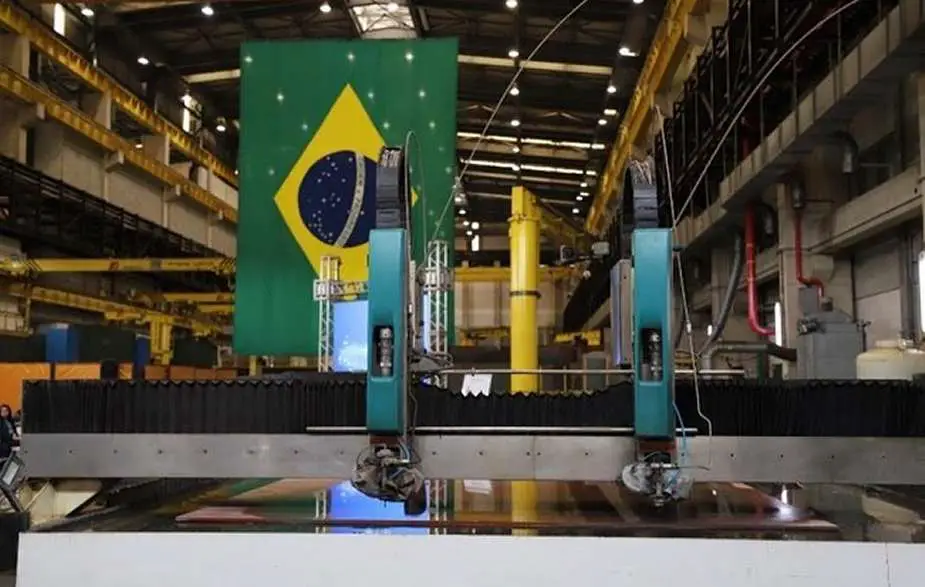According to information published by Vejo on October 10, 2023, the Brazilian Navy marked the commencement of the construction of its first-ever nuclear-powered submarine.
Follow Navy Recognition on Google News at this link
 Steel cutting ceremony of the first Brazilian nuclear-powered Alvaro Alberto. (Picture source: Brazilian Navy)
Steel cutting ceremony of the first Brazilian nuclear-powered Alvaro Alberto. (Picture source: Brazilian Navy)
This significant milestone began with a steel-cutting ceremony at the Itaguaí Naval Complex in the metropolitan area of Rio de Janeiro, attended by prominent civil and military figures, as well as experts from the nuclear industry.
The project's initial phase involves crafting a "qualification section," a crucial segment weighing around one hundred tons. This section will serve as a testament to the technical expertise of Itaguaí Construções Navais, the company behind the project. Upon successful evaluation, the shipyard will advance with the full construction, targeting the vessel's delivery by 2029.
The introduction of a nuclear-powered submarine is set to address various national challenges. Beyond being a state-of-the-art naval asset, it represents the intricate nature of submarine design and construction.
The endeavor also includes the development of specific nuclear technology, such as the creation of its reactor and the entire onboard nuclear plant. The prototype, known as LABGENE, is already under advanced construction in Iperó, São Paulo.
Furthermore, as part of a broader Submarine Development Program established between Brazil and France in 2008, there are plans to construct four additional conventional diesel-electric propulsion submarines for the Navy.
About the submarine Alvaro Alberto
As Brazil's first nuclear-powered attack submarine, it is a product of the strategic partnership between France and Brazil, formalized on 23 December 2008 by then-presidents Luiz Inácio Lula da Silva and Nicolas Sarkozy.
This partnership gave birth to the Submarine Development Program, aiming to modernize the Brazilian Armed Forces' naval component. The Álvaro Alberto is the fifth unit of the Riachuelo-class, drawing inspiration from the French Scorpène-class.
Upon its completion, Brazil will join an elite group of nations, becoming the seventh country globally to operate nuclear submarines. This achievement is even more notable as Brazil might be the first new operator of this ship type since 1987, a title previously held by India with the INS Chakra, a former Soviet Navy Charlie-class submarine.
Tracing back the history, the Brazilian Navy's ambition for a nuclear submarine began in the 1970s. The vision was clear: Brazil needed mastery over the nuclear fuel cycle, a modern submarine hull, and a national nuclear reactor for naval use.
The journey began in earnest in 1979, under the leadership of Army generals Ernesto Geisel and João Figueiredo. By 1982, Brazilian scientists had achieved significant milestones in uranium enrichment.
Fast forward to 23 December 2008, Brazil secured a deal with France for four Scorpène-class conventionally-powered submarines, marking a pivotal moment in the nation's naval aspirations. This partnership also facilitated the transfer of technology, empowering Brazil with the knowledge to design and construct modern submarine hulls.
The Submarine Development Program, initiated in 2010, became the cornerstone of Brazil's submarine ambitions. With the Madeira Island base in Rio de Janeiro serving as the hub for submarine development and manufacturing, Brazilian engineers received training in France, and by 2018, over 400 of them were actively involved in the nuclear submarine project.
Despite challenges, including funding delays and program freezes, Brazil made significant progress. By 2020, the country had initiated the production of nuclear fuel for the Álvaro Alberto, and by 2022, discussions with the International Atomic Energy Agency about nuclear fuel inspections were underway.
The Brazilian Navy's modernization program envisions the development and construction of six nuclear submarines. Central to Brazil's defense strategy is the concept of deterrence. With a nuclear fleet, Brazil aims to ensure that it can withstand any initial hostile actions and deter further aggression.
Technical data
The Álvaro Alberto is a nuclear attack submarine developed by Brazil. It has a displacement of 6,000 tons, measures 100 meters in length, and has a beam of 9.8 meters.
The submarine is powered by a pressurized water reactor that generates 48 MW or 64,000 hp, using low-enriched uranium at 20%. This is complemented by a nuclear turbo-electric engine, giving the submarine a speed of up to 25 knots. Her range is determined by its nuclear fuel, which can last up to 25 years.
The submarine can accommodate up to 100 personnel. For defense and offense, it is equipped with six 533 mm torpedo tubes that can launch cruise missiles, anti-ship missiles, heavy torpedoes, and deploy naval mines.



